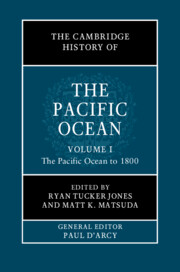Book contents
- The Cambridge History of the Pacific Ocean
- The Cambridge History of the Pacific Ocean
- The Cambridge History of the Pacific Ocean
- Copyright page
- Contents
- Figures
- Tables
- Contributors to Volume I
- Frontispiece
- General Editor’s Introduction
- Preface to Volume I
- Part I Rethinking the Pacific
- Part II Humans and the Natural World in the Pacific Ocean
- Part III Deep Time: Sources for the Ancient History of the Pacific
- Part IV The Initial Colonization of the Pacific
- 16 Pleistocene Voyaging and Maritime Dispersals in the Pacific
- 17 Early Maritime Navigation and Cultures in Coastal Southern China, Taiwan, and Island Southeast Asia, 6000–500 BCE
- 18 New Guinea’s Past: The Last 50,000 Years
- 19 Austronesian Colonization of the Pacific Islands, 1200 bce–1250 ce
- 20 Seafaring and Colonization in the Southern Ocean, 1000 ce–1850 ce
- 21 Polynesians in Central-South Chile
- Part V The Evolution of Pacific Communities
- Part VI Europe’s Maritime Expansion into the Pacific
- References to Volume I
- Index
21 - Polynesians in Central-South Chile
Sailing Eastwards
from Part IV - The Initial Colonization of the Pacific
Published online by Cambridge University Press: 11 November 2022
- The Cambridge History of the Pacific Ocean
- The Cambridge History of the Pacific Ocean
- The Cambridge History of the Pacific Ocean
- Copyright page
- Contents
- Figures
- Tables
- Contributors to Volume I
- Frontispiece
- General Editor’s Introduction
- Preface to Volume I
- Part I Rethinking the Pacific
- Part II Humans and the Natural World in the Pacific Ocean
- Part III Deep Time: Sources for the Ancient History of the Pacific
- Part IV The Initial Colonization of the Pacific
- 16 Pleistocene Voyaging and Maritime Dispersals in the Pacific
- 17 Early Maritime Navigation and Cultures in Coastal Southern China, Taiwan, and Island Southeast Asia, 6000–500 BCE
- 18 New Guinea’s Past: The Last 50,000 Years
- 19 Austronesian Colonization of the Pacific Islands, 1200 bce–1250 ce
- 20 Seafaring and Colonization in the Southern Ocean, 1000 ce–1850 ce
- 21 Polynesians in Central-South Chile
- Part V The Evolution of Pacific Communities
- Part VI Europe’s Maritime Expansion into the Pacific
- References to Volume I
- Index
Summary
For about a century, observers explained the striking prehistoric cultural parallels between Polynesia and South America as cultural borrowings travelling from west to east. There are more than 5,000 references to trans-Pacific parallels in pre-Hispanic times.1 They refer not merely to isolated elements of material culture, cultigens, linguistic features, or even music, but to a complex of traits representing a worldview and their representation in myth, astronomy, divination, and specific rites.2 In 1829, the British missionary William Ellis was the first to observe a link between Polynesia and America. In 1835, Tahitian resident Jacques Moerenhout was the first to highlight specific ethnographic parallels between southern Chile and Polynesia which he observed during trading voyages between Tahiti and Valparaiso.3 Moerenhout thought these were Polynesian borrowings, including the sewn-plank canoe from Chiloé Island, but did not believe that these could travel such long distances. In 1924, John Macmillan Brown identified new Polynesian elements, mentioning quipu (means of recording information through knotted cords), cooking ovens, and toki (stone adzes), elements that had come from New Zealand or the Marquesas to southern Chile, thence to Peru.
- Type
- Chapter
- Information
- The Cambridge History of the Pacific Ocean , pp. 480 - 496Publisher: Cambridge University PressPrint publication year: 2023



